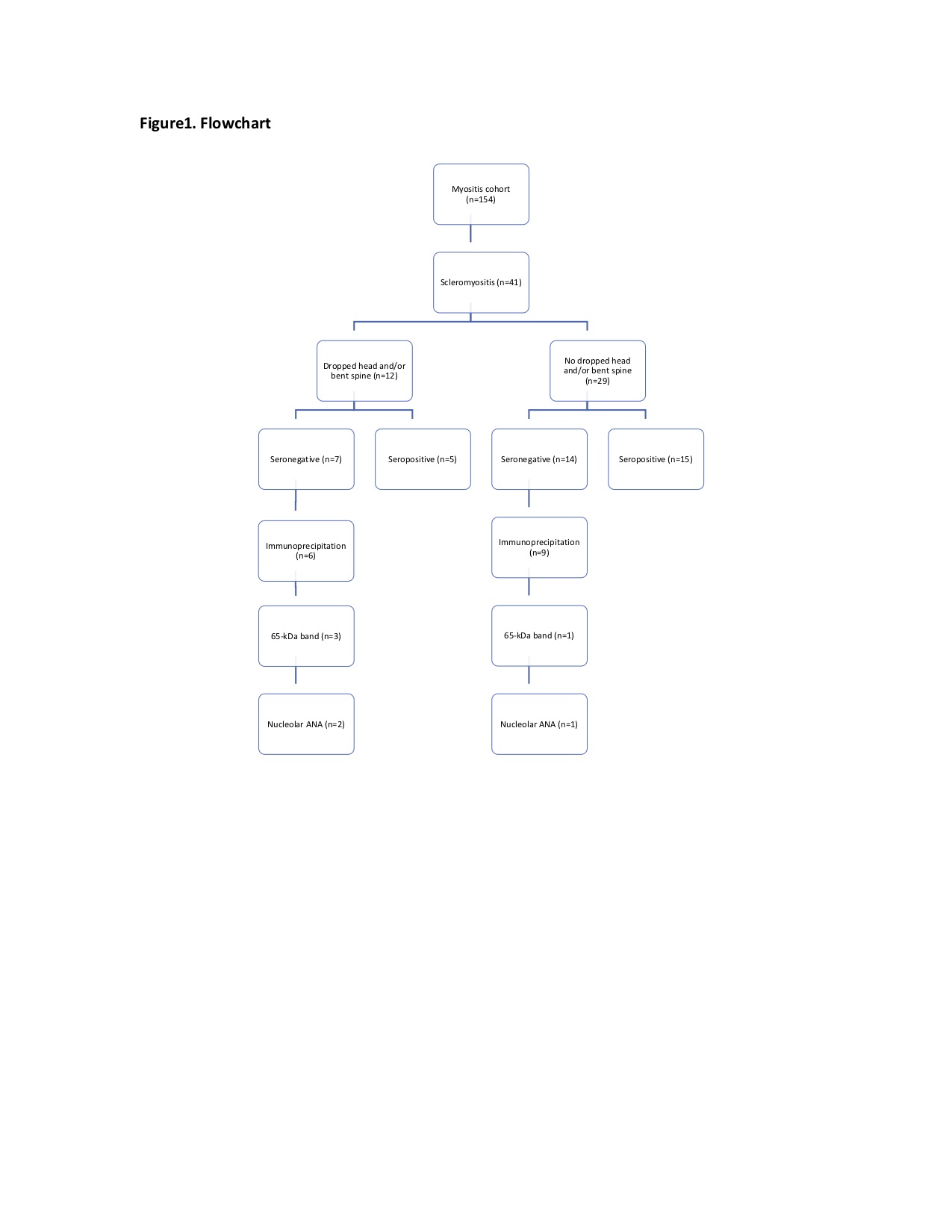Session Information
Session Type: Poster Session C
Session Time: 9:00AM-11:00AM
Background/Purpose: Scleromyositis (SM) is an emerging subgroup of autoimmune myositis associated with features of systemic sclerosis (SSc). There is a paucity of data on scleromyositis associated with head drop and/or bent spine. The aim of this study was therefore to describe the clinical and serological features of scleromyositis patients presenting with head drop and/or bent spine as the dominant myopathic feature.
Methods: All patients with a diagnosis of SM were identified from a research cohort of 154 autoimmune myositis patients. In the absence of a gold standard, the clinical diagnosis of SM was based on expert opinion (consensus of ≥2 experts). SM patients were grouped according to the presence or absence of dropped head and/or bent spine. Clinical and serological data were collected and stored using a standardized protocol. Sera from patients with no known SSc-specific (anti-centromere (ACA), -topoisomerase I (Scl-70) (ATA), RNA polymerase III (RNApol), -Th/To, -fibrillarin) or SSc-associated (anti-PM/Scl), -Ku, -U1RNP) were tested by immunoprecipitation (IP) of 35S-methionine-labeled cell extracts. Descriptive statistics were used to summarize the data.
Results: Forty-one SM subjects were identified (Table 1). The majority were female (80%) and mean age at diagnosis was 55 years (range: 20-81). Most of the SM subjects had Raynaud’s phenomenon (85%) and all had abnormal nailfold videocapillaroscopies. Although the majority had proximal weakness (85%), more than 50% also had distal weakness. Head drop and/or bent spine was the dominant myopathic feature in 12 (29%) SM patients. In those with head drop and/or bent spine compared to those without, SSc skin involvement was more common (84% vs 59%), interstitial lung disease (ILD) was less frequent (8% vs 55%), and peak creatine kinase level was lower (median 283 IU/L (range: 84-1488) vs 877 IU/L (range: 48-5075)). Only 5 of 12 patients (42%) with dropped head and/or bent spine had SSc-specific or -associated antibodies, including -RNApol III (n=2), Th/To (n=1) and PM/Scl (n=2). Among patients without known antibodies, IP was performed in 15 subjects: 6 of 7 subjects with and 9 of 14 subjects without dropped head and/or bent spine (Figure 1). Among these 15 patients, a 65- kiloDalton (kDa) band was identified in 3 subjects with, and 1 subject without, dropped head and/or bent spine. Three of the four patients with a 65-kDa band had a nucleolar pattern on HEp-2 indirect immunofluorescence staining. The subjects with a 65-kDa band had limited skin disease (3/4) and dysphagia (3/4) but no ILD or arthritis. The subject with a 65-kDa band without dropped head and/or bent spine had a nucleolar IIF and predominantly distal weakness.
Conclusion: Dropped head and/or bent spine was a dominant myopathic feature in a third of our scleromyositis patients. An autoantibody recognizing a 65-kDa protein represents a novel autoantibody associated with scleromyositis presenting with dropped head and/or bent spine. Further studies to identify the 65-kDa autoantibody target are underway.
To cite this abstract in AMA style:
Venne K, Leclair V, D'Aoust J, Landon-Cardinal O, Albert A, Beauchemin J, Brunet D, Roy L, Ellezam B, Karamchandani J, Massie R, O'Ferrall E, Meyer A, Troyanov Y, Satoh M, Fritzler M, Hudson M. A Novel Autoantibody Recognizing a 65-kDa Protein Is Associated with Scleromyositis with Head Drop and/or Bent Spine [abstract]. Arthritis Rheumatol. 2020; 72 (suppl 10). https://acrabstracts.org/abstract/a-novel-autoantibody-recognizing-a-65-kda-protein-is-associated-with-scleromyositis-with-head-drop-and-or-bent-spine/. Accessed .« Back to ACR Convergence 2020
ACR Meeting Abstracts - https://acrabstracts.org/abstract/a-novel-autoantibody-recognizing-a-65-kda-protein-is-associated-with-scleromyositis-with-head-drop-and-or-bent-spine/


